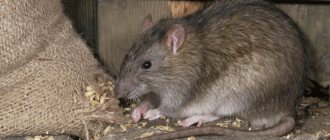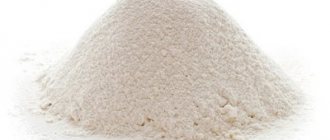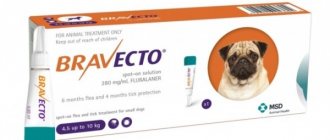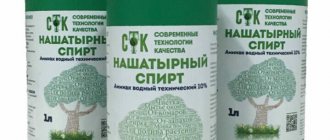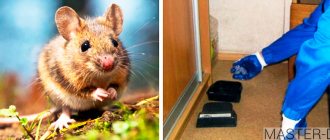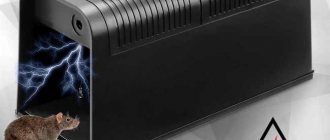How do glue traps work and how effective are they?
The glue trap is a mini-book, which, when opened, will reveal an adhesive composition applied to the “pages of the book.”
The mouse gets stuck in this viscous substance, unable to get out. These devices are absolutely non-toxic and safe for humans and pets.
Let's celebrate! These devices are effective only on mice and young rats, and an adult rat will be able to get out of the “sticky trap.”
Composition and principle of action
The principle of operation of a glue trap for mice and rats is that the glue against rodents needs to be distributed over a small surface of the floor or objects located in places where they accumulate. The animal, running through the sticky trap, will get stuck in the mixture and will not be able to escape from it.
Rat catching glue contains substances such as polybutylene, polyisobutylene and cyclosan. Together they form a viscous mixture that remains sticky for a long time. Thus, not one, but several individuals of mice or rats can fall into a mouse trap at once.
The effectiveness of the glue trap will increase if there is a mouse bait in the middle of the glue coating. This could be a piece of cheese or sausage, bread crumbs, cereal or seeds. Many manufacturers add special aromatic substances to rat glue that attract rodents with their scent. Therefore, it is not necessary to use additional mouse baits.
Popular and effective adhesives
Manufacturers recommend sprinkling the traps on top with grains or pieces of bread. The best bait for mice is sunflower seeds or lard skins.
Glue Alt
Alt glue is produced in Russia. This is a colorless, odorless gel composition. Non-toxic, but when it enters the gastrointestinal tract, it sticks together with the mucous membrane, which provokes tissue death.
More than 80% of the composition is polyisobutylene, and 9.6% each is polybutylene and cyclosan. Sold in metal tubes of 135 g. Price 150-250 rubles. It is enough to apply no more than 20 g of glue to one plate. The composition is effective against rodents, less dangerous than poisons.
The sheet with glue and bait must be installed in a clean, dry place. The mousetrap is checked no more than once a week. The caught pest is thrown away along with the trap.
Viola is also used in vegetable warehouses, clinics, grocery stores, and kindergartens.
The mixture is harmless to humans, but contact with the skin should be avoided and stored away from children at temperatures from +5 to +30 °C.
Kotofey
Glue Kotofey from Russian. Packaged in tubes of 135 g. The main components are polybutylene, butyl rubber and cycloisane. They are non-toxic and harmless to humans. The product is very sticky and can be applied to cardboard, plastic or wood.
To catch parasites, 15-20 g of the composition is enough. It is applied to a plate measuring 15x20 cm, which is then installed in a clean, dry place. The glue is stored at a positive temperature no higher than +40 °C in a dry room, separate from food products. Shelf life: 3 years
Stores sell ready-made Kotofey plates based on the glue of the same name. To use, simply remove the protective layer and install it in a place where mice are constantly active.
If the mixture gets on your skin, you can remove it with a swab dipped in solvent. Afterwards, wash the area with soap and water. If glue gets into your eyes, wash them with water or a 2% baking soda solution.
Clean house
Russian glue against rodents “Clean House” consists of butyl rubber, gum, polybutylene and cyclocaniol. It has a gel-like consistency, does not harden for a long time, and has strong stickiness and viscosity. Indicators do not decrease in damp rooms. The colorless composition is packaged in metal tubes of 130 g. The packaging price is about 150 rubles. "Clean House" is non-toxic, but tasting it is not recommended.
To prepare a trap for a rodent, you need to take a 15x20 cm cardboard and apply 20 g of the substance on top of it. Do not spread the product with your hands to avoid sticking. To attract the attention of parasites, cheese, bread crumbs or other bait are placed in the center of the plate.
Trap
Kapkan glue helps fight small parasites and insects. It eliminates cockroaches, bedbugs, mosquitoes, and ants. It contains no toxins, so it is harmless to people. It can ruin your pet's fur if it accidentally gets stuck to it.
The trap is stored at a temperature of +5…+30°C.
To catch rodents and insects, the product is installed along their regular path. To catch flying insects, hang a plate with glue on the wall.
Other brands
- RaTrap – adhesive composition against parasites and insects, keeps even large pests away. Produced in the Czech Republic. Non-toxic, contains food attractant as bait. Packaged in tubes of 135 g.
- EuroGuard – a means for mechanically catching mice, rats and insects. Can be used at low temperatures, which is important when pests have infested in the basement or freezer. Produced in Italy.
Disadvantages of Using Sticky Traps
Like any product, mouse glue is not without its drawbacks in use. Here are the most common:
- Inhumanity. Perhaps this is one of the main negative qualities of this remedy: a slow and cruel death awaits a rodent in a trap. If he is found still alive, then the pest hunter himself will have to suffer, since he will have to think about how to get rid of him. Not everyone is capable of finishing off a helpless little mouse, but throwing it still alive into the garbage chute is no less heartless.
- Allergic activity (hyperallergenicity). There have been cases when substances contained in the glue caused irritation and allergies in people sensitive to them. The sticky trap does not have poison that kills the rat; the rodent dies from exhaustion, which is extremely inhumane
- Extremely difficult to remove glue. Getting glue from sticky traps on children's skin and pet hair is very common. At the same time, it is almost impossible to remove the substance from hair or fur. The only effective way to get rid of matted hairs or hairs is to completely cut off the affected areas. To remove the sticky substance from the skin, you have to use strong chemicals, such as solvent.
- The cry of the victims. Rodents, having fallen into a trap, emit a loud cry for a long time, sometimes a squeal, which is very difficult to hear and sometimes even scary.
The problem of ethics in this case is especially acute. Of course, it is necessary to fight rodents, but if you wish, you can always find a more humane alternative.
Glue reviews
According to reviews, the effectiveness of all means is high; as they say, the mice stick tightly.
Some users complain that the substance is too thick, making it difficult to squeeze out. “Kotofey” is recognized as the most viscous. Others, on the contrary, are irritated by the “liquidity” that is unable to hold the captive.
You can check the consistency before purchasing.
A tube with a thick product is unlikely to deform under pressure, but a container with a thinner composition will leave a dent.
When shaking, pay attention to the nature of the sound inside the package - squelching indicates a watery consistency, the absence of such indicates thickness.
Some people don’t like the fact that caught rodents have to be disposed of, which, by the way, is better done by burning. Some people are annoyed by the death squeak of the captives, and they consider this method of fighting inhumane - the animal dies from hunger and thirst. Other disadvantages include the following:
- not suitable for catching larger rodents such as rats;
- when it gets on clothes, floors or interior items, it leaves marks that are difficult to get rid of;
- at subzero temperatures or temperatures above 30 ° C, the glue does not cope with the task.
Rules for using the adhesive composition
Using the substance is not difficult; you can carry out the process yourself. To do this, you must follow the instructions:
- Take a piece of smooth and flat material - cardboard or plastic - no smaller than 10x10 cm for mice and 25x20 for rats. For the latter, it is additionally advisable to attach the selected material to the floor using self-tapping screws, otherwise the animal may drag the entire trap with it and stain the room with an adhesive substance. A cardboard sheet is perfect for applying the adhesive composition.
- When fighting mice, you should lubricate the substrate with glue in strips 1-2 cm wide, maintaining a distance between them of up to 4-5 cm.
- To catch rats, stripes are drawn wider and at a greater distance. The substance acquires irreversible stickiness half an hour after application.
- It is recommended to place bait in the middle of the trap, for example bread soaked in vegetable oil.
Rat traps should be placed in places where victims are more likely to appear - in corners, next to walls and partitions, directly next to burrows, at a distance of 3 to 15 m from each other, based on the volume of the room, its clutter with furniture and the number of pests .
For maximum effectiveness of a glue trap for rats, you need to place it in places where rodents are often found.
At the same time, it is necessary to ensure isolation from children and animals and minimize contamination of the sticky surface; therefore, it is safer to place traps under furniture, inclined towards walls or in special bait houses.
Glue traps must be inspected frequently to see if new animals have been caught and, if this happens, replaced with fresh ones.
If the trap is used for rats, then it is enough to examine it once a day. This is explained by the fact that the caught animal will emit danger signals (squeaking), which is why its fellow tribesmen will avoid this place. But when mice are caught using glue, this factor turns out to be insignificant - these rodents easily run into the trap in a group in a short period of time. Mice are much less cautious animals than their larger relatives; therefore, several victims often fall into one trap at a time.
How to use glue to catch mice
Using glue to catch mice, rats and insects is very easy. Instructions for use are almost the same for all brands.
- You need to take a flat base made of wood, cardboard or plastic. Its size will depend on the type of pest. A piece of 10x10 cm is suitable for catching mice, and 25x20 cm for rats. Since rats can sometimes be very large and can drag the trap along with them, the plate must be screwed to the floor with screws.
- If there are mice in the house, then glue should be applied to the plate in strips, the width of which may not exceed 10-20 mm. In this case, the distance between them should be 50 mm. When a trap is prepared for rats, the thickness of the adhesive strips should be 30-50 mm, and the distance between them should be 0.1 m. The composition acquires maximum adhesiveness half an hour after application.
- If the mice do not fall for the glue, you need to place a bait in the center of the plate, which can be bread soaked in sunflower oil, millet, seeds, etc.
- Mouse traps should be installed in places where parasites often walk (in the corner, along walls, partitions, near rat holes). The distance between traps should be 3-15 m, depending on the size of the room, its load of furniture and the number of rodents. The finished trap must be installed correctly so that children and pets do not have access to it. It is better to place it under furniture, cover it with boards or use special bait houses.
- The glue plate is periodically checked for the presence of “prey”. Trapped pests are collected and disposed of to prevent the spread of corpse odor. Rat glue is checked every day, since the caught animal will make loud noises, scaring away its relatives. The mouse trap can be checked less frequently; these animals are not as cunning as rats.
- The most painless method of disposal is to place a rag soaked in gasoline or acetone on top of the rodent. The mouse will first faint, then suffocate. The option cannot be ruled out that the trap along with the mammal is simply thrown into the trash, but at the same time the animal suffocates painfully and for a long time in the waste. The most cruel thing is to kill an animal with a hammer or other blunt object.
The glue retains its quality for a long time without drying out in the air. Remains effective until it becomes exposed to debris and dust. Therefore, it is recommended to change the glue plate every week.
What to do with caught victims
When adhesive users first turn to this method of catching pests, they often have the question of what to do with the caught rodents. The choice of the most appropriate option from an ethical point of view remains up to the hunter himself . There is only one piece of advice that will allow you to deal extremely humanely with a captured animal. To alleviate his suffering, you can generously wet a piece of cloth with gasoline or acetone and place it on top of the caught victim. She will first lose consciousness, and after that, being in an unconscious state, she will suffocate.
To make it easier for a rodent to die in a glue trap, cover it with a piece of cloth soaked in gasoline or acetone.
Few are ready for such actions. Traps are most often simply thrown into the garbage chute with mice still alive, leaving them in a painful and hopeless situation.
There is an opinion that the substance in the trap gradually dries out, but this is not the case. Due to its special composition, it retains its effectiveness until its layer becomes dirty with dust, sand from the street, flour or dirt. For this reason, it is advisable to change the substrate with the substance approximately every 6-7 days.
Types of glue traps against mice and rats
There are a lot of adhesive sticky “traps” on sale and the difference between them is mainly in shape or size. Conducted sociological surveys made it possible to identify the most popular adhesive traps from the total number of adhesive traps on the market.
CatchExpert
- The adhesive plates produced by an Argentine company are shaped like a book and measure 17 by 25 centimeters.
- The adhesive viscous composition applied to the cardboard base has the property of not drying out for a long time, thanks to special additives.
- The glue applied to the surface always has a protective layer and it will need to be removed before placing sticky devices.
Rodentoff
Under the Gryzunoff brand you can find various variations of adhesive devices. They can be in the form of sheets, plastic trays or prefabricated cardboard houses.
There are universal Velcro strips on sale that can catch both mice and rats. But there are also targeted trapping devices - specifically from rats and specifically from mice.
Any version of the Gryzunoff sticky trap has the same technical characteristics.
The adhesive base is created using:
- mineral oil;
- rubber;
- rosin;
- special fragrances - attractants.
Thanks to the fragrances, there is no need to place additional bait on the sticky surface.
Note! Thanks to the components of the adhesive composition, it has the ability not to harden for more than a hundred days, which increases the efficiency of using these devices.
Trap
- The Kapkan glue trap is a universal means for catching rodents.
- The possibility of using these “traps” is quite wide, including places where the use of chemical rodenticides is absolutely not possible.
- The adhesive layer of the trap is made of rubber and plant resin, which attract rodents with their aroma.
- These strips have a fairly thin layer of cardboard under an adhesive backing. This is done so that the installed “trap” does not stand out too much from the surface on which it will be located.
Glue "Clean House"
Glue Clean house from rodents and insects is a popular substance that can be used in different rooms.
The composition is a mixture of three components:
- Polybutylene – 76.6%.
- Cyclocaniol – 10.9%.
- Polyisobutylene – 12.4%.
It has several main advantages:
- Does not freeze for a long time.
- High viscosity, adhesion.
- Does not deteriorate with prolonged exposure to moisture.
- Safe glue for pets and people.
- Low cost.
Efficiency is increased by adding bread, cheese, and cereal to the sticky layer.
Forsyth
An effective trap that differs from other names. Its peculiarity is that it has a specific smell that attracts rodents. During operation, the room temperature cannot be increased above +30 degrees. Used to combat small animals and insects. It does not emit harmful substances, which is why it is used in hospitals, educational institutions, and food storage warehouses.
MR mouse
There is also a name for a special glue that is packaged in tubes. The finished trap is a plate measuring 20x15 cm. It can be effectively used against mice, rats, and insects. It does not contain harmful substances, so the device is considered safe for the human body and pets.
Block
Devices used to catch mice, rats, insects. The record must be removed from the packaging, the protective film removed, and placed in a pre-designated place. The temperature range that the sticky surface can withstand is from +5 to +50 degrees. Using bait you can increase the effectiveness of the trap.
Kotofey
If all previous adhesive devices are disposable, then the Kotofey sticky traps are reusable.
To do this, the kit includes ten adhesive layers, a plywood plate and special clamps for fastening.
The sticky layer is placed on a plywood board using clamps and after a rodent gets on it, it is simply unhooked and disposed of.
The adhesive base is based on:
- polybutylene;
- polyisobutylene.
Good to know! The adhesive composition does not contain any chemical components, which indicates the safety of using this device in human and domestic animal habitats.
Mr. MOUSE
These traps are made in several types:
- in the shape of a house;
- in the form of plates.
Any chosen form is convenient to use - just remove the protective layer and place the trap in places where “gray robbers” are likely to appear.
The adhesive composition does not contain chemical compounds, which allows the plates to be placed in food storage areas.
Types of rodent repellents
- Ready-made mouse traps. They represent a base with glue evenly distributed over it, the smell of which attracts small pests. To use, you need to remove the protective layer from the board and install the trap in a convenient place. To catch mice and other rodents in the house, it is better to place traps in places where parasites often appear.
- Mouse glue. Sold in jars or tubes. The glue must be applied in an even layer. The products do not dry out during use.
The cardboard on which the rat catching mixture has been applied is used once. Sometimes grains and sunflower seeds are sprinkled onto the adhesive composition for additional attention to pests. The animal sticks first with one paw, then rests on the glue with the other and is completely glued. When a pest is caught, it dies not from injury or poisoning, but from hunger and thirst.
When a mouse dies, it begins to decompose and smell unpleasant, so it should be thrown in the trash or destroyed by another method along with the cardboard.
Safety precautions
Despite the fact that mouse glue does not emit toxins or poisons, you should adhere to some safety measures:
- Wear disposable rubber gloves before applying the product.
- Apply glue to the base using a brush or sponge. You can't do this with your hands!
- Remember that glue traps should be kept out of the reach of children and pets. If possible, completely limit entry into the room until the pest is caught.
- After all manipulations, you must wash your hands with soap and running water.
- If glue does get on your skin, you can wash it off with acetone or special gasoline. After finishing work, be sure to wash your hands thoroughly with soap. If the product gets on your hair or fur, it is extremely difficult to wash it off and most often you have to remove the contaminated area with scissors.
DIY mouse glue
There is also a recipe for making mouse glue with your own hands. To do this you will need rosin, petroleum jelly, pine resin, and bitumen pitch. But since making glue for mice with your own hands is not so easy, it is easier to purchase a ready-made product in a store. Moreover, the average price of products is in the range of 150-300 rubles. Traps will cost a little more, with the price scale directly proportional to the complexity of the design.
Glue for rodents is effective and safe . But sometimes, even despite the powerful composition of the product, it is not possible to catch the mouse. It is worth trying a different drug or choosing a more humane method of bullying. For granaries it is easier to purchase special poison or mousetraps.
In a house where there are children, it is better to have a cat. If you don’t want to kill rodents, but just need to scare them away, then use ultrasonic devices that emit sounds that can only be heard by animals.
How to replace mouse glue
In some situations, the use of glue is impossible or ineffective. In this case, there are several alternative options:
- You can use a traditional mousetrap. The rodent will be killed without your assistance. All you have to do is throw it away.
- Mummifying poison. Quite a convenient way to fight rats. But then the dead rat or mouse will lie under the furniture, where you will not be able to see or reach it.
- Loose poison. This type of poison is suitable only in rooms where there are no other inhabitants. The bright color of the drug can attract a child or pet. In addition, a cat or dog can eat a poisoned rodent.
- Ratcatcher cat. A rather unusual method of controlling rodents, but very effective.
- Ultrasonic repeller. The most modern method. It is based on the fact that a device inserted into a socket emits a sound that cannot be heard by humans, but cannot be tolerated by mice and rats. They just run away.
Which is better, a glue-based trap or a repellent one?
- Ultrasonic waves help effectively rid a room or area of rodents 24 hours a day. There is one “but” - the animals do not die, they simply run away under the influence of the waves. The device emits danger alarms, and the animals leave all their shelters and migrate to other places.
- Glue has the opposite effect - rodents fearlessly run to the trap, thinking that it is an ordinary piece of board or cardboard. If you put a piece of meat or cheese in the center of a sticky trap, the animal will definitely become interested. It's up to you to decide whether to let the rat go or let it die.
- The glue is not very easy to use. It is necessary to correctly calculate the distance between traps, because the smaller the rodent, the smaller the interval between the substrates. It is necessary to calculate the correct application of glue.
- In the case of repellers, it is enough to plug the device into a socket (50–60 cm from the floor), the sound coverage area is 150 m2.
- Using glue can get your hands dirty; after catching, the backing with the dead animal must be removed, this is not very pleasant.
- Every 10 days, the traps are bypassed; if you forget about this, the animal corpses may decompose and there will be an unpleasant smell in the room. Ultrasound devices can become addictive in rodents, and the signal will no longer produce the desired effect.
To understand what products you will need to fight rats and mice, you need to consider many factors. First of all, the specifics of the room in which they live are important, because in canteens and cafes the use of many chemicals is prohibited. Consider the number of rodents, as well as whether there are pets and children in the house. It is best to use a combined method of control - they will definitely give 100% results.
Source
Alternative to glue and cool traps
There are a number of alternative options that can replace anti-mouse glue. They have their own characteristics, which leads to changes in operating rules.
These include:
- Classic mousetraps. The death of a rodent occurs almost instantly. It is important to choose the right bait, choose a place to install the device and not leave your own odors. Rodents can successfully bypass them due to non-compliance with clear installation rules.
- Poison. It can only be used in rooms where there are no people or pets. Prohibited for use in hospitals and food storage warehouses. Poisoned mice and rats come out of hiding. But some of them die in hard-to-reach places, decomposing in the process. On sale you can find a poison that mummifies the carcasses of animals, thereby eliminating the persistent, unpleasant odor.
- Ultrasonic repeller. It is a compact device that connects to a common network. Creates ultrasonic waves that are inaudible to humans. Rodents are frightened by this sound. They begin to avoid the room where the device is operating. However, over time, mice can become accustomed to ultrasound. As a rule, rats are repelled by signals with a frequency of 20-50 kHz, mice by 10-20 kHz.
Many owners of private houses or apartments get a cat. This pet will not only create a more comfortable environment and delight others, but will also prevent mice from appearing. But in this case, the feline family is likely to catch some kind of infection or even get poisoned through a poisoned rodent carcass, which happens to almost all animals.
